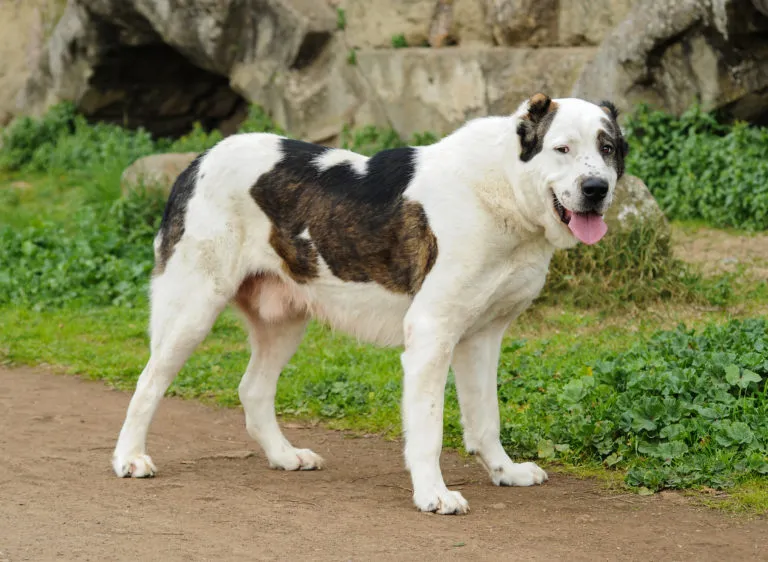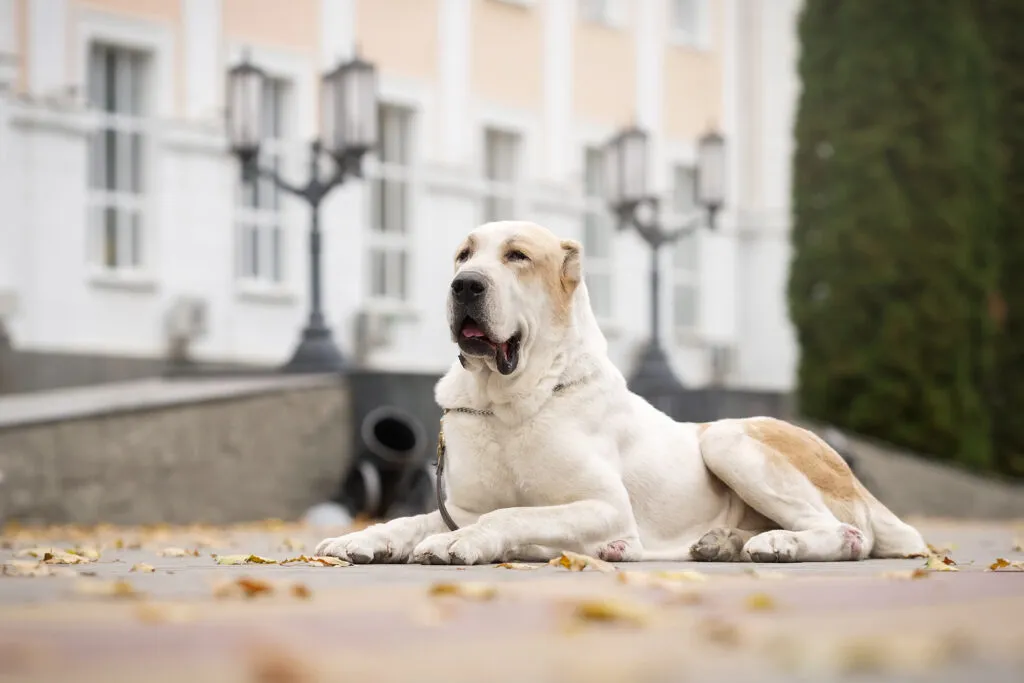Medium Size Poodle
With its large, powerful build and massive head, the Central Asian Shepherd Dog is an imposing sight. This guardian dog, which comes in various types, stands out not only for its strong protective instinct but also for its calm and composed nature.

© Ricant Images / stock.adobe.com
The Central Asian Shepherd Dog’s coat adapts to climate: short to long topcoat with a thick undercoat, in a wide range of regional color patterns
This isn’t a dog for everyone, as its body build already suggests. Male Central Asian Shepherd Dog can grow up to 78cm tall and weigh up to 79kg, while females can reach up to 69cm in height and weigh up to 69kg.
Their muscular physique and massive heads give an impression of the endurance, power, and strength this breed possesses.
Upon closer inspection, you’ll notice significant differences between the various types of this breed. Due to its extensive range – spanning from the Caspian Ocean to China – the breed has a variety of types differing in body build, colour, hair length, and temperament.
Though it’s challenging to categorise all the different types precisely, broadly speaking, the subtypes can be grouped according to climate zones:
 © Aler / stock.adobe.com
© Aler / stock.adobe.com
The length of the topcoat varies according to the different climatic conditions in Central Asia and the respective region of origin, ranging from short to mid-length to long. All types share a dense and well-developed undercoat, protecting them from the cold. This is essential since it can get extremely cold at night, not just in the high mountains but also in the deserts.
Considering the many local variations, the FCI standard, led by Russia, is quite generous and allows a wide range in size, weight, hair length, and colour of the dogs.
The Ovtcharka’s broad spectrum of colours includes white, black, grey, straw-coloured, fox red, brown-grey, as well as tiger-striped, pied, or spotted combinations.
The Central Asian Shepherd Dog is not easily rattled. Even in threatening situations, it remains calm and maintains its remarkable inner peace. However, this calm temperament should never be underestimated, as protecting its people is paramount for this guardian dog.
If it senses its herd or family is in danger, it will attack without warning. The courage, self-confidence, and fighting strength of this breed are immense.
Due to its pronounced protective instinct and inherent mistrust of strangers and other dogs, the Central Asian Shepherd Dog is only partially suitable as a family dog.
It takes a lot of consistency, patience, and self-confidence for this dominant and strong-willed dog to submit to its owner. Typically, it will only accept one leader and will continuously test this person’s competence.
Lack of leadership — whether through excessive harshness or well-meaning leniency — can quickly lead to unwanted behaviours. Despite their generally balanced temperament, these independent dogs can act aggressively.
Thus, consistent training and lifelong guidance are essential for a harmonious relationship between humans and the Central Asian Shepherd Dog.
The Central Asian Shepherd Dog feels most at ease when performing the tasks it was originally bred for: protecting livestock herds and accompanying shepherds in remote areas. Only here can it satisfy its almost insatiable urge for movement and fully express its territorial protective instinct.
When properly engaged, this nomadic dog proves to be highly adaptable. Its “shepherd” will find it to be a reliable and skilled guardian, which, despite its independence and self-confidence, also has a surprisingly affectionate, nearly tender side.
As a nomadic dog, the Central Shepherd is relatively low-maintenance—not just in terms of food portions but also in its care. Its short to mid-length fur is very resilient and requires minimal maintenance. However, it should be brushed regularly to remove dirt and maintain healthy hair structure.
Additionally, trim the claws to avoid injuries. Regularly check and clean the teeth, ears, and eyes.
Particularly during the growth phase, ensure the dogs don’t grow too fast. Rapid growth caused by excessive protein intake during the growth months is one of the leading causes of later joint issues.
Besides a rather low-protein diet given in smaller portions about three to four times a day, young dogs should also be physically spared during this phase. Avoid having them climb stairs or taking them on long hikes.
Once the Central Asian Shepherd is fully grown, you can increase the protein content in its food. The main component of the dog food should be high-quality meat, whether cooked or fed as raw food. Alternatively, you can use commercially prepared food mixes in dry or wet forms.
No matter your preferred feeding method, it’s important that the ingredients and composition of the food meet the dog’s needs. Depending on age, gender, size, activity level, and living environment, the necessary nutrient compositions can vary significantly. There isn’t a single right food for the Shepherd.
The answer to this question isn’t the same for all dogs of this breed. Provided the ingredients are correct, the Central Asian Shepherd generally gets by with surprisingly small portions.
Usually, fully grown dogs need two meals a day, given at consistent times. Overly large portions, too many snacks between meals, and lack of rest after eating can increase the risk of gastric torsion, which also affects Central Asians.
The Shepherd is neither a typical family dog nor suited for city life. This freedom-loving and independent dog struggles with the living conditions in European industrial nations.
This guardian dog is best suited for livestock farmers living in remote, isolated areas. Those living far from the city with spacious property and seeking an adept guard dog might consider owning a Central Asian.
However, experience and a certain know-how in dog training are prerequisites for keeping an Ovtcharka.
Besides, an owner must have time and patience. The socialisation and training of this confident dog, which doesn’t have much respect for blind obedience, is hard work.
Because Central Asian dogs tend to be dominant, they need a handler who sets firm boundaries but also has the necessary sensitivity (which should not be confused with leniency) to show that it’s worth trusting and following their human.
Keeping an Central Asian as a house and companion dog isn’t advisable. This doesn’t mean an Shepherd can’t live with people. In a family that appreciates its natural guarding and protective instincts and allows it to take on its original task of guarding home, yard, and livestock, the Ovtcharka shows itself to be adaptable and people-oriented.
Breeders of the Central Asian Shepherd, or the “Middle Asian Shepherd Dog” as the breed is also known, typically focus on one specific type. While various types are occasionally interbred, this has often been done randomly rather than to enhance specific traits.
A dog from a trustworthy breeder typically costs around £2,000.
Despite the somewhat limited gene pool of the Central Asian types, the breed is still considered very healthy and extremely robust. Owners have little to worry about breed-specific diseases. However, as with other large breeds, joint issues, especially knee problems, do occasionally occur.
Just as diverse as the different types of Shepherd, so too is the breed’s place of origin. It spans the republics of Kazakhstan, Kyrgyzstan, Tajikistan, Uzbekistan, Afghanistan, Turkmenistan, through Mongolia, the Ural, and Siberia.
Centuries ago, the ancestors of the Central Asian Shepherd were valued guardian dogs, reliably and fearlessly protecting livestock and shepherds from attackers, and accompanying nomadic tribes through steppes and over high mountains. They proved to be extremely endurance, adaptable, and undemanding, coped excellently with the harsh living conditions.
To this day, the Central Asian works as a guardian dog in Central Asian regions, accompanying livestock through steppes and mountains. Although the breed remains rare in Europe and is considered endangered, its range in Central Asia is vast.
However, in these regions, the breed isn’t known by the name “Central Asian Ovtcharka” (Russian: Sredneaziatskaya Ovtcharka). Depending on the region and language, the breed has various names, underscoring the diverse purposes and traits of the different types.
Dogs included in the Central Asian Ovtcharka breed:
Efforts are underway to recognise some local types as distinct breeds; however, there are no official breed clubs as in Europe or America in the origin countries.
Although the Ovtcharka isn’t technically a Russian breed, Russia was the first country to amalgamate the different types into one breed, establishing an official standard for the Central Asian “Shepherd Dog” (which Ovtcharka translates to).
Fans of the Bearded Collie agree that those who aren't familiar with this dog breed simply have to get acquainted with it. And those who have experienced how a Bearded Collie bolts across meadows with its flowing fur, how it rolls around full of energy and joy and how it attentively and observantly takes into account its owners wishes become simply addicted to this original dog breed and its unique charm.
The Goldendoodle isn't a breed, but a pairing between Golden Retrievers and Medium or Standard Poodles. Marketed as a low-maintenance dog for allergy sufferers, this hybrid is enjoying increasing popularity amongst dog lovers, similar to the Labradoodle.